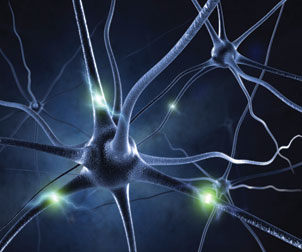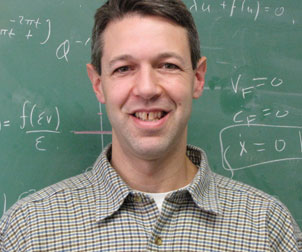Pitt Researchers Using Mathematics to Target Parkinson’s Disease Symptoms

University of Pittsburgh mathematicians have been collaborating with Pitt’s School of Medicine to find ways to stop the symptoms of Parkinson’s disease, thanks in part to a four-year, $1.86 million grant from the National Science Foundation (NSF) and a five-year $1.2 million grant from the National Institutes of Health (NIH). The NSF grant began in 2007 and has funded a number of research projects within Pitt’s Department of Mathematics; the NIH grant is in its first year.
Pitt mathematicians, working with neurobiology researchers, are using computational models, experiments, and analysis of models and data to study the way that signals are transferred between the basal ganglia, a collection of nuclei found in the brain that helps with motor control, and the thalamus, its downstream target in the brain. Although scientists can’t yet prevent the cell death associated with Parkinson’s, their study of mathematical patterns could guide the development of less invasive treatments that block the motor symptoms of the disease.
“For Parkinson’s patients, there are more spurts and pauses in neural activity, and the firing of groups of neurons becomes more coordinated, leading to tremor and other symptoms,” said Jonathan Rubin, Pitt professor of mathematics and one of the principal investigators on the project. “The neuronal activity is like a woodpecker knocking on a tree outside your window; it distracts you when it first starts pecking, and then the silence grabs your attention when the pecking suddenly stops. Similarly, the starts and stops in the neuronal activity can become disruptive to signal processing in the brain.”
Rubin said this firing pattern may be what leads those with Parkinson’s to experience shaking, rigid muscles, and difficulty in making quick movements. Currently, if side effects of drug treatments become too strong, surgeons fight these symptoms with deep brain stimulation, an aggressive but commonly used surgical treatment in which an implanted electrode literally penetrates the brain and sends out electrical impulses.
 Jonathan Rubin
Jonathan Rubin“It’s not quite understood how deep brain stimulation works,” said Rubin. “But it may be similar to the white noise of a window fan: It’s right there in your window next to you, so it’s potentially more distracting than a woodpecker. But actually, the regularity of the rhythm is less disruptive for you and your brain.”
Pitt researchers are trying to understand the neuronal activity patterns so they can improve the deep brain stimulation procedure, making it more individualized and efficient.
Along with Rubin, the principal investigators of the NSF award for the study of complex biological systems across multiple space and time scales are G. Bard Ermentrout, Distinguished University Professor of Computational Biology and professor of mathematics at Pitt; David Swigon, Pitt professor of mathematics; and Ivan Yotov, professor and chair in Pitt’s Department of Mathematics. The NSF grant partially funded the work of mathematics graduate student Pamela Reitsma, who carried out preliminary computational studies on the flow of signals from the basal ganglia under the supervision of Rubin and Brent Doiron, Pitt assistant professor of mathematics.
The principal investigators of the NIH grant are Pitt researchers Robert Turner, professor of neurobiology at Pitt; Brent Doiron, assistant professor of mathematics; and Rubin.
Other Stories From This Issue
On the Freedom Road

Follow a group of Pitt students on the Returning to the Roots of Civil Rights bus tour, a nine-day, 2,300-mile journey crisscrossing five states.
Day 1: The Awakening
Day 2: Deep Impressions
Day 3: Music, Montgomery, and More
Day 4: Looking Back, Looking Forward
Day 5: Learning to Remember
Day 6: The Mountaintop
Day 7: Slavery and Beyond
Day 8: Lessons to Bring Home
Day 9: Final Lessons

